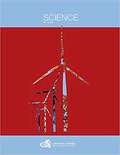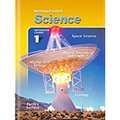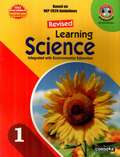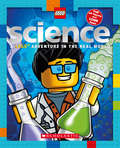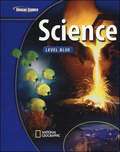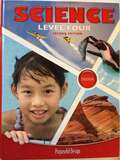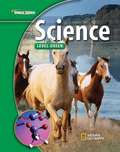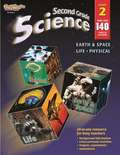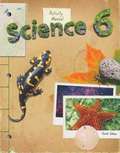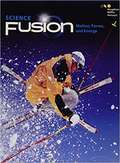- Table View
- List View
Science: An Issues-based Program (Grade #7)
by Manisha Hariani Sara Dombkowski Din SeaverScience textbook for 7th graders.
Science: Earth and Space
by Jeremy Foster Delores Shimmin Dawn Mckenzie Erica Martin Dewitt Steele Christine Hotke Greg ParkerScience textbook with a Christian perspective.
Science: Earth and Space
by Delores Shimmin Greg Parker DeWitt SteeleScience: Earth and Space has many features designed to make your study of earth and space science interesting and beneficial.
Science: Forces and Motion (Chapter 12A)
by Scott ForesmanScience 2006 Leveled Reader: Forces and Motion, Grade 3, Chapter 12 A by Scott Foresman
Science: Grade 6 Student Textbook
by Barbara Ferrier Timothy EimerThe following topics are covered in this grade level: Immune and Nervous Systems, Diversity of Life, Energy, Electricity, Matter, Weather, and Flight. Textbook includes: readings to reinforce the concepts presented in the classroom, numerous hands-on activities to enhance the lessons, colorful photographs, updated illustrations, graphs, and diagrams, a glossary of scientific terms (with pronunciation guides for more difficult words), questions to promote both recall and synthesis of ideas and concepts, and idebars with interesting information to enrich lessons. Text layouts have been updated to include colored tabs to easily differentiate units. Unit and chapter page numbers appear in the table of contents for quick reference.
Science: Integrated Course 1
by Mcdougal-Littell Publishing StaffIntegrated Science pulls together units from the different categories of science to give you a broad picture of how scientists study nature.
Science: Integrated With Environmental Education class 1
by Dhiren M DoshiCordova Learning Series-Science for classes 1 and 2 is strictly written according to the guidelines recommended in the latest National Curriculum Framework suitable for CBSE, ICSE and other State Board Schools. The main objective of this series of Science is to provide students a clear and logical presentation of the subject so as to develop: Scientific Concepts and Fundamentals and their application in solving the problems in their day-to-day lives. Scientific Skills like Observation, Enquiring, Performing Hands-on Activities and Experiments, Recording and Communicating Information. Scientific Attitude and Temperament.
Science: LEGO Nonfiction
by Penelope Arlon<p>Did you know that the blue whale could blow up 1,250 balloons in a single breath? Or that the Earth's core is as hot as the surface of the sun? <p>Including information about almost every scientific topic in the universe, readers will find out everything they ever wanted to know about fascinating animals, electricity, energy, weather, our galaxy, technology of tomorrow, and so much more. They'll even meet real-life scientists and read all about their exciting work. Complete with hundreds of stunning photographs, fun facts, mini comics, and building ideas, LEGO Science is the perfect book for young readers curious about science. Includes a buildable scientist minifigure! <p>This is a fixed-format ebook, which preserves the design and layout of the original print book.</p>
Science: Level Blue
by Glencoe/McGraw-HillWith a broad array of innovative print and technology resources, "Glencoe Science" helps teachers differentiate and accommodate all learners! The range of labs, content area reading, discussion strategies, note-taking tools, and activities provides students with multiple experiences of each Science Standard. They give teachers flexibility and the ability to monitor student progress through ongoing assessment. .
Science: Level Four
by Purposeful Design Publications Various RolesScience level four by Purposeful Design... The world you live in is amazing in it's beauty, complexity, and order! Science lets you explore and learn about how things are made and how they work. God designed you to be inquisitive. God wants you to see Kim! Jeremiah 29:13 "You will seek me and find me when you seek me with all your heart"
Science: Level Green
by Glencoe/McGraw-HillTry this new Integrated Science program that features a balance of inquiry and content.
Science: Life, Physical, Earth And Space (Science Series)
by Steck-Vaughn StaffSteck-Vaughn Second Grade Science features over 140 activities across earth & space science, life science, and physical science. Background information, cross-curricular activities, projects, experiments, and assessments are provided, along with a line-listed answer key in the back. 176 pages, reproducible for home/classroom use. 2nd Grade.
Science: Matter and Energy
by Jeremy Foster Delores Shimmin Dewitt Steele Gregory ParkerPrepare your child for chemistry and physics through the foundational principles taught in Science: Matter and Energy. Start out with scientific measurements and the different forms of matter and graduate into the foundations of chemical reactions and properties of magnets and electricity. With proofs for Creation, section and chapter reviews, and over 500 pictures, charts, and graphs, your child will be able to smoothly transition into chemistry from his study of Science: Matter and Energy.
Science: Matter and Energy Lab Manual
by Foster; Bunch; Kim; SochVisually reinforce a concept with the Science: Matter and Energy Laboratory Manual. Correlated with the topics contained in Science: Matter and Energy, this manual presents 29 regular labs plus optional appendix labs covering a variety of topics from science investigation and engineering design to physics and chemistry. With each lab, we’ve included a materials supply list, detailed step-by-step instructions, report sheets, and critical thinking questions. Your students will be thrilled to learn with these fun and instructional demonstrations.
Science: Matter and Energy Laboratory Manual
by Jeremy Foster Tom Stone Dewitt Steele Gregory Parker Brian Mcdivitt Verne Biddle Barbara PorcherReinforce concepts taught in class with the 36 demonstrations in this Laboratory Manual. These labs are designed for the teacher to perform the demonstration with assistance from the child. Study volume, density, buoyancy, levers, magnetization, electric circuits and more with the hands on activities specifically detailed in these demonstrations. Each lab comes complete with a stated purpose, introduction, equipment list, instructions, and lab sheet for reporting results. Bring chemistry and physics concepts to life with this Laboratory Manual.
Science: Matter and Energy Quizzes
by Jeremy Foster Christine Hotke James RidgleyAs a parent, you know that you must inspect what you expect. Inspection provides key motivation to your teen to work hard and provides you with valuable assessment of his strengths and weaknesses as you guide his progress. Let A Beka help you make that inspection easy with these ready-made quizzes. The quiz book correlates with the text Science: Matter and Energy (2012), Science: Matter and Energy Tests, and Science: Matter and Energy Teacher Edition, which includes the curriculum/lesson plans. Answers and grading guidance are sold separately in Science: Matter and Energy Quiz Key. Grade 9. <p><p> Product Features<p> · The 39 quizzes provide weekly reinforcement of concepts.<br> · Each quiz contains 10 objective questions, taking a minimum of class time to take and to grade.<br> · A variety of formats such as multiple choice, modified true/false, matching, completion, and math problems prepares your teen for the tests and verifies that he understands a concept, no matter how it is presented.<br> · Each quiz includes the page numbers it covers in the text, making the quizzes adaptable to your schedule and your teen’s learning progress.
Science: Matter and Energy Tests
by Jeremy Foster Christine Hotke James RidgleySafety principles, repair basics, innovation tools—all depend on a proper understanding of God’s principles of design and His laws governing the universe. From Bernoulli’s principle to the second law of thermodynamics, you can know that your teen is understanding how some things work while other things can’t through these well-designed tests that reinforce and evaluate his learning. The test book is correlated with the texts Science: Matter and Energy (2012), Science: Matter and Energy Laboratory Manual, Science: Matter and Energy Quizzes, and Science: Matter and Energy Teacher Edition, which includes the curriculum/lesson plans. Answers and grading guidance are sold separately in Science: Matter and Energy Test Key. Grade 9.<p><p> Product Features<p> · Objective questions in a variety of formats test on multiple levels from recall and understanding to application.<br> · Since mathematics is the language of science, many tests include an application section of math problems corresponding to the problems demonstrated and practiced in the text. Your teen will see the necessity of both math skills and scientific knowledge as they are applied to practical life situations.<br> · Essay questions take your teen’s thinking skills to a higher level as he must explain the hows and whys of science. They also open his eyes to note God’s design in the physical world and to consider how things of man’s design work. Noting others’ creativity may lead to his own!<br> · Testing every three weeks (for a total of 12 tests) provides vital reinforcement of learning and an opportunity for your evaluation of your teen’s comprehension.<br> · Two nine-weeks exams and semester and final exams further reinforce concepts. Exposure to the concepts through reading, discussion, demonstration and practice, independent work, quizzes, tests, and then review examinations cements course content.<br> · Since every test clearly indicates the sections of the text it covers, you can adjust test taking to your teen’s progress through the text.<br> · As with all A Beka tests, the content and design reflect our half century of educational experience. directions are easy to understand and the layout is appealing. Test content is clearly covered in the course materials and is appropriate for the grade level.
Science: Order & Design
by Jeremy Foster Delores Shimmin Dawn Mckenzie Erica Martin Laurel Hicks Gregory RickardStudents are introduced to the scientific method and encouraged to apply it throughout this Christian life science text. They investigate fields such as botany, anatomy, zoology, microbiology, and ecology with the goal of discovering the thoughts of the Creator through the ingenious structure and orderly function of His creation.
Science: Student Activity Manual, Grade 6
by Bju PressThe Science 6 Activity Manual provides pages to record results and conclusions for Activities as well as reinforcement pages, study guides, and enrichment pages.
Science: Teaching School Subjects 11-19 (Teaching School Subjects 11-19)
by Keith S. Taber Vanessa KindIn recognizing that new teachers often feel disempowered by the subject expertise they bring into teaching, this book not only covers the training standards for NQTs and the Induction Standards, but takes the reader beyond this by fully exploring issues relating to subject knowledge in learning to teach.Divided into three sections the book covers: framing the subject - defining subject knowledge and focusing on questions about science as a school subject teaching the subject - looking at pedagogical, curricular and pupil knowledge science within the professional community - focusing on the place of science within the wider curriculum and the teaching community. This refreshing new book provides stimulating assistance to subject specialists, from new teachers of science in the early years of professional development to those on a PGCE course or in their induction year. It is also suitable for subject leaders with mentor responsibilities and Advanced Skills Teachers undertaking specialist inset and teaching support.
Science: Teaching School Subjects 11-19 (Teaching School Subjects 11-19)
by Keith Taber Vanessa KindIn recognizing that new teachers often feel disempowered by the subject expertise they bring into teaching, this book not only covers the training standards for NQTs and the Induction Standards, but takes the reader beyond this by fully exploring issues relating to subject knowledge in learning to teach. Divided into three sections the book covers: framing the subject - defining subject knowledge and focusing on questions about science as a school subject teaching the subject - looking at pedagogical, curricular and pupil knowledge science within the professional community - focusing on the place of science within the wider curriculum and the teaching community. This refreshing new book provides stimulating assistance to subject specialists, from new teachers of science in the early years of professional development to those on a PGCE course or in their induction year. It is also suitable for subject leaders with mentor responsibilities and Advanced Skills Teachers undertaking specialist inset and teaching support.
Science: Technology and Society Sourcebook
by Holt Rinehart Winston StaffScienceplus Sourcebook for High School
Science: The Diamond Edition
by Scott ForesmanA book about Living and Non-living things, Habitats, How Plants and Animals Live, Life Cycles and Food Chains.
Science: The Diamond Edition
by Scott ForesmanThis book contains topics on Life Science (Classification, Cells, Reproduction, Body Systems, Plants, Biomes, Plate Tectonics, Rocks and Minerals and Reshaping Earth's Surface), Earth Science (Earth's Resources, Climate and Weather), Physical Science (Matter, Building Blocks of Matter, Forces and Motion, Machines, Changing Energy Forms, Thermal and Light Energy), Space and Technology (Earth, Sun, and Moon, The Universe and Impacts of Technology).
ScienceFusion Interactive Worktext: Module I: Motion, Forces, And Energy
by Houghton Mifflin Harcourt StaffScienceFusion: Student Edition Interactive Worktext Module I: Motion, Forces, and Energy 2017

